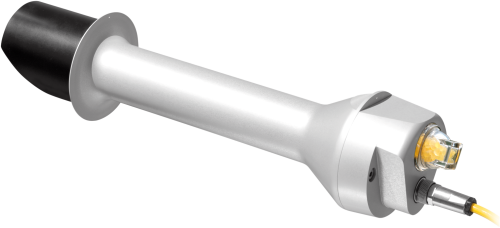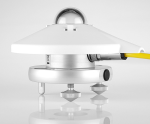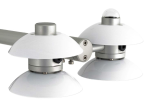This product is no longer available.

| Services Available |
|---|
Overview
The CHP1-L, manufactured by Kipp & Zonen and cabled by Campbell Scientific, is a pyrheliometer used for unattended direct solar-radiation measurements. It is designed specifically to measure the direct beam solar irradiance with a field of view limited to 5 degrees. This is achieved by the shape of the collimation tube, precision apertures, and the detector design.
Read MoreBenefits and Features
- ISO First Class
- Built-in temperature sensors
Images

Detailed Description
To monitor direct normal irradiance, a CHP1 Pyrheliometer is mounted to a user-supplied sun tracker such as Kipp & Zonen's Solys2. The CHP1 pyrheliometer measures the direct-beam solar irradiance with a field of view limited to 5 degrees. The limited field of view requires the CHP1 to be continuously pointed toward the sun. The Solys2 Sun Tracker rotates on two axes and uses a GPS receiver to keep the CHP1 aimed at the sun throughout the day.
Specifications
| Sensor | Pyrheliometer |
| Measurement Description | Measures the direct beam solar irradiance with a field of view limited to 5 degrees |
| Spectral Range | 200 to 4000 nm |
| Sensitivity | 7 to 14 µV/W/m2 |
| Response Time | < 5 s |
| Zero Offset B | < 1 W/m2 |
| Temperature Dependence of Sensitivity | < 0.5% (-20° to +50°C) |
| Field of View (FOV) | 5° ±0.2° |
| Operating Temperature Range | -40° to +80°C |
| Non-Linearity | < 0.2% |
| Maximum Irradiance | 4000 W/m2 |
| International Standards | First Class ISO |
| Body Diameter | 3.8 cm (1.5 in.) |
| Base Diameter | 7.6 cm (3.0 in.) |
| Length | 31.6 cm (12.4 in.) |
| Weight | 0.9 kg (1.98 lb) excluding cable |
Documents
Frequently Asked Questions
Number of FAQs related to CHP1-L: 12
Expand AllCollapse All
-
Every two years.
-
Ideally, the window should be cleaned every morning.
-
Absolutely. Because the CHP1-L measures the direct beam solar irradiance, it must follow the sun and remain within the limits of the 5 degree field of view to provide accurate measurements.
-
The CHP1-L is a pyrheliometer, manufactured by Kipp & Zonen, that measures the direct beam irradiance from the sun within a 5 degree solid angle around the sun.
-
Yes, but only under certain conditions. The most common condition for a negative output signal occurs during nighttime measurements when the temperature of space is less than the sensor’s temperature.
-
Yes. The internal temperature can be measured using either the PT100 or thermistor built into the sensor.
-
A pyrheliometer, such as the CHP1-L, has a window through which sunlight enters. The sunlight, or incident solar short-wave radiation, is directed onto an electronic device called a thermopile. Using the thermoelectric effect, the thermopile acts as a large thermocouple that measures the temperature of a particular body—in this case, the sun. The thermal energy is converted into a voltage output signal that can be recorded by Campbell Scientific data loggers.
-
The CHP1-L is typically mounted to a user-supplied sun tracker, such as Kipp & Zonen’s Solys2 or EKO Instruments’ STR-21G/22G.
-
Most Campbell Scientific sensors are available as an –L, which indicates a user-specified cable length. If a sensor is listed as an –LX model (where “X” is some other character), that sensor’s cable has a user-specified length, but it terminates with a specific connector for a unique system:
- An –LC model has a user-specified cable length for connection to an ET107, CS110, or retired Metdata1.
- An –LQ model has a user-specified cable length for connection to a RAWS-P weather station.
If a sensor does not have an –L or other –LX designation after the main model number, the sensor has a set cable length. The cable length is listed at the end of the Description field in the product’s Ordering information. For example, the 034B-ET model has a description of “Met One Wind Set for ET Station, 67 inch Cable.” Products with a set cable length terminate, as a default, with pigtails.
If a cable terminates with a special connector for a unique system, the end of the model number designates which system. For example, the 034B-ET model designates the sensor as a 034B for an ET107 system.
- –ET models terminate with the connector for an ET107 weather station.
- –ETM models terminate with the connector for an ET107 weather station, but they also include a special system mounting, which is often convenient when purchasing a replacement part.
- –QD models terminate with the connector for a RAWS-F Quick Deployment Station.
- –PW models terminate with the connector for a PWENC or pre-wired system.
Case Studies
The small southern Alberta city of Medicine Hat is the first city in the world......read more
Privacy Policy Update
We've updated our privacy policy. Learn More
Cookie Consent
Update your cookie preferences. Update Cookie Preferences





